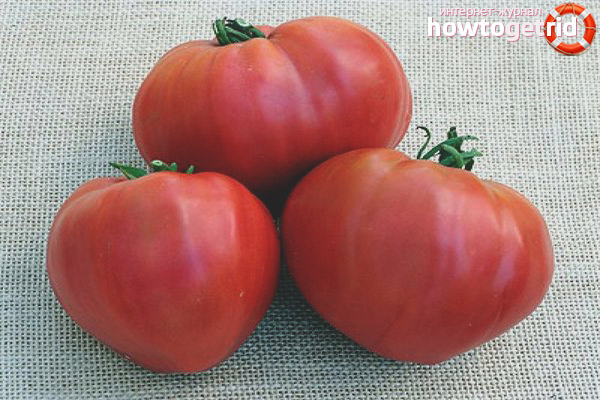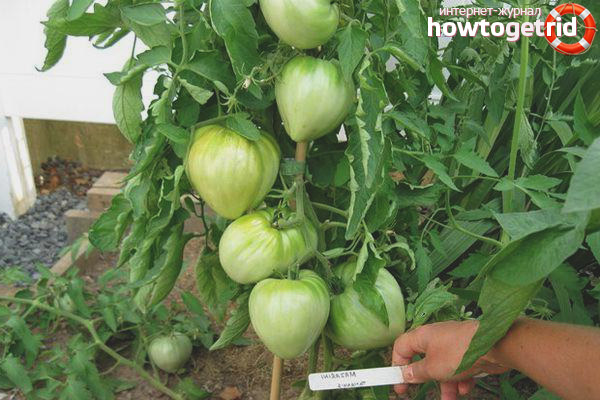The content of the article
Tomato Kosovo is a productive variety native to Serbia. The plant is indeterminate, up to 1.8 m, with large pink fruits in the form of a heart. The pulp is juicy, sweet, fleshy. Tomatoes are good for fresh consumption, for the preparation of salads, they also prepare tomato juice, pasta, ketchups. A large amount of solids and carotenoids, in particular lycopene, accumulate in the fruits.
Description
The bush is powerful, razlogy. The culture is grown in two or three stems, tied to a support, the lower leaves and stepsons are removed. This variety produces beautiful, very tasty fruits. The first flower-bearing brushes in the variety Kosovo appear at the end of June. The variety has an advantage: the fruits are not affected by gray rot, do not crack.
Kosovo is a mid-season variety with high yields. Its distinguishing feature is large, fleshy pink. There are not many seeds in tomato cells. The positive quality of the variety can be considered the possibility of the appearance of ovaries at high temperatures. With proper care and agricultural technology, achieving positive results will not be difficult.
Advantages:
- Long shelf life.
- Resistance to transportation over long and medium distances.
- High sugar and lycopene in fruits.
- Fruits in some cases reach 700 grams.
The disadvantages include the impossibility of whole canning.
Cultivation and care
If you decide to grow tomatoes in the country, then you should familiarize yourself with the rules of planting, agrotechnical methods of cultivation, the basic requirements for caring for this crop.
As a rule, these plants prefer illuminated places. Tomatoes are not recommended for planting on sandstones and in windy areas.
When growing tomatoes, picking is of particular importance. When shoots appear in the box where the seeds were sown, they are covered with sifted fertile soil with a layer equal to the thickness of 1-2 seeds.
- When two or three true leaves appear, the plants dive into a 20 cm deep box filled with loose fertile soil. Then dive several more times. This contributes to the strong development of the root system and the plants themselves. Such bushes bear fruit well, give a plentiful harvest before the onset of frost.
- In the garden, a plot for tomatoes is selected even, well-lit. Plants are arranged in two rows, from south to north. In the fall, under digging to a depth of 25-30 cm with a turnover of the reservoir, make 1 sq. Km. m one bucket of well-rotted humus and 300 g of wood ash. In the spring, the soil is dug without a turnover of the reservoir.
- Given that tomato culture is photophilous, they plant it only in the rows of fruit trees. Tomatoes are hygrophilous, but excessive soil moisture should not be allowed to avoid damage to the bush bushes by rotting and late blight.
- In the dry season, plantations are watered 2-3 times a week from the tank with a hose with a sprayer, but in no case with cold water from the well. Water should warm in the sun.
- The mulch laid around plants, and even better throughout the row, retains moisture very well in the soil. Systematically destroy weeds and loosen the soil.
- When grown from seeds, plants sometimes turn out to be heterogeneous. Some grow strongly, but give low yields and many stepsons, while others, remaining small bushes, give much more fruit.
- In the process of planting seedlings on the bottom of the holes, it is desirable to put humus, it must be connected to the upper fertile layer of soil. You can add superphosphate to the same hole. In the absence of this component, you can use wood ash.
Tomatoes are negatively tolerated by the lack of water. As a result of drying, small but well-observed cracks will appear on the upper layer of the crust. Proper watering of seedlings after planting is a mandatory procedure that is urgent.
When planting, it is advisable to treat the roots with a solution of clay with mullein, the so-called "talker". Often there is added a growth regulator such as heteroauxin.
The smallest distance between seedling bushes when planting in open ground is 50-70 cm. Experienced gardeners select seedlings from tomatoes with good qualities. By selection, you can get good yielding plants on your site. Tomato Kosovo is widely known among gardeners due to the increased yield and size of the fruit.
Video: Kosovo tomatoes











Submit